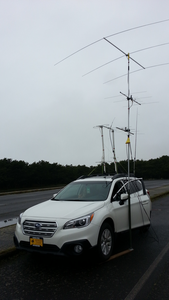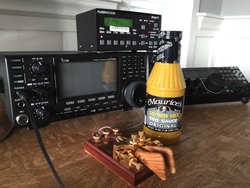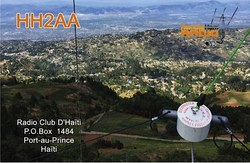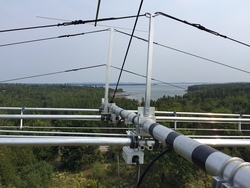 January 27, 2016 Editor: Paul Bourque, N1SFE | |||||
IN THIS ISSUE
NEW HF OPERATORS - THINGS TO DO
On most weekends it's there can be multiple contests sharing the same mode. If you're operating in one contest, it's helpful to at know the exchanges you might be asked for by participants in the other contests - a nice way to boost both parties' scores. The ARRL VHF contest and Winter Field Day partially overlap this year on January 30th. If you participate in Winter Field Day, you could be leaving points on the table by NOT looking to 6m and 2m for contacts. A similar situation with "3 QSO Parties at once!" occurs the weekend of February 6 with Vermont, Minnesota, and British Columbia QSO Parties. The weekend of May 7-8, there are FOUR simultaneous QSO Parties. He's back, and he's running the Contest Branch! Bart Jahnke, W9JJ, has been named as ARRL Contest Branch Manager. One of Bart's personal goals for the contest branch is to shorten the cycle between contest end and the publishing of contest results, while upholding the quality and integrity of the scoring process. Welcome Bart! Are you comfortable talking in front of a room full of people about something you've done recently that could be of interest to a contest-oriented crowd? Doug, K1DG, would like to talk to you about being a speaker at the 2016 Dayton Hamvention's Contest Forum. If you have ideas for a topic that should be covered in the forum format, please send them to Doug. The sixth running of the "Maine 2 Meter FM Simplex Challenge" will occur on February 15, 2015 starting at 1700 UTC. True to its name, contacts are limited to the 2 meter band. (KB1HNZ) The Southeastern VHF Society (SVHFS), North East Weak Signal Group (NEWS) and Mt. Airy VHF Radio Club (Pack Rats) have come together to sponsor the first-ever "VHF Super Conference" April 14-17, 2016, at the Holiday Inn Washington-Dulles International Airport in Sterling, Virginia. Hosted by the Grid Pirates Contest Group and Directive Systems and Engineering, many of VHF's movers, shakers, and top operators will be on hand. More details will be forthcoming on the conference web site.
The North and South Carolina QSO Parties have announced some incentives enhance the appeal of participating in their event on February 27-28th. Anyone who submits a log will be eligible for a drawing to win a Carolina Style BBQ Dinner with all the trimmings. There are other incentives for mobile operators, as well as a special "Hunley Challenge" award. The New Hampshire QSO Party has changed its 2016 date to September 17-18, 2016, according to Mark, K1RX. The web site will be updated to reflect these changes soon. BUSTED QSOS In the story about Winter Field Day in the last issue, "Thom Proehl's callsign is K7FZO... Thom and his XYL Teena, K9HAV, manage Valley Camp, where several ham radio related events are hosted during the year." - Rick, N6NR Bill, AI5I, also sent in the link to the article on LF transmissions affecting the Van Allen radiation belt boundaries. Complete information for all contests follows the Conversation section January 28 January 29 January 30 January 31 February 1 February 2 February 3 February 4 February 5 February 6
February 7 February 8 February 10 In 1898, a time of great early innovation in radio, J.C. Bose was working with radio signals at 60 GHz. Yes, 60 GHz. Yet we don't see his name mentioned very often. This article summarizes much of his work, and provides a link to learn more. Intel recently announced some new features for their vPro chips and hardware, one of which allows the remote use of any WiDi equipped display. This feature is intended for conference room settings and the like. But imagine its use to remote the screen of the run station to a large wall mounted display for the on-deck operators to observe... A few years ago, Radio Arcala placed the ability to operate real ham radio inside a virtual world , and we as contesters and amateur radio operators look (longingly?) at the popularity and growth of online gaming. Here's an article on some of the techniques that are used to make virtual worlds appear more real. Especially intriguing are the some of the ways that intentional misdirection can be used into the system to constrain motion in the real world, yet seem to provide 'infinite horizons.' Ah, 807s! The quintessential vacuum tube. The US Naval Observatory is working with industry to develop accurate, synchronized, distributed timekeeping functionality when GPS is unavailable. This could be useful in highly urbanized areas, or areas (such as canyons) where the view to the GPS constellation is limited. Liquid metals such as gallium, and alloys of gallium (which does not have the toxicity of Mercury) are being used to make re-configurable, tunable antennas in the laboratory . The frequencies discussed by the researchers are 700 MHz and above... Microchip Technology, purveyor of PIC processors, is purchasing Atmel, maker of the AVR chips central to Arduinos and variants. As the eastern seaboard of the US digs out from under the Nor'easter this week, consider the finding that current-carrying concrete could melt snow from roads. Someone in Delaware is using a webcam and some image processing to automatically measure the snow depth in their backyard. They did it for fun, not accuracy. Eutectic is both an adjective and a noun. A eutectic is a mixture of substances, the combination of which melts (and solidifies) at a single temperature. That temperature is lower than the melting points of the individual substances. A eutectic of 63% tin to 37% lead has customarily been used for non-ROHS soldering applications. One type of lead-free solder uses 99.3% tin to 0.7% copper. Some events of WRTC 2014 have been chronicled in N3BB's new book entitled Contact Sport: A Story of Champions, Airwaves, and a One-Day Race Around the World, which will be released in early February. Ask for it at your library, or find it at your local or online bookseller. "If it was easy - it wouldn't be as rewarding when it happens!!" - Tree, N6TR's comment regarding working VP8STI on Topband. Tree will be the featured speaker at the 2016 Dayton Topband dinner. The Texas QSO Party Results have been posted. The write-up by Chuck, NO5W, is comprehensive and interesting - it includes the categories and scores, but also covers information on mobile setups, station strategy, the log scoring process, and even pitfalls to avoid in logging. It's an engaging read even if you did not participate in the contest! VE4XT recently received the award for " Canadian Automobile Journalist of the Year ." Congratulations! OPERATING TIP - For SSB Pileup success, offset! Rob, N7QT, one of the members of the recent VK9WA DXpedition, suggests: "If you are trying to work a mult, and there are a lot of callers, try calling about 200 Hz off their frequency. That's sometimes enough to differentiate you from the rest of the crowd." On the Topband reflector, a discussion of methods of protecting beverages and other low-frequency receiving antennas from high-energy events like lightning or static discharge yielded the suggestion by Rick, K2XT: "Get some gas tubes from Mouser. I use 652-2049-12-BT1LF. 62 cents each last time I ordered about a year ago. Any surges are shorted around the device (resistor or transformer). The gas tubes have no effect whatsoever on the normal operation. Simply connect one across your terminating resistor, and one across the fed end wouldn't hurt either. The maintenance won't end, but the maintenance due to lightning induced surges will. No, they won't protect against a direct hit on the Beverage, but then you would have to find the 500 feet of wire first!" "Here's an Interesting summary of amateur TV experiments in HD and even the proposed ATSC 3.0 commercial broadcast standard" - (KK6DA from Elecraft mailing list) A conductive glue that researchers are working on may one day replace solder in some applications. It binds to metal, as well as glass. The glue does not withstand high pressures or high temperatures. Researchers are rethinking incandescent bulbs, and understanding how to optimize them for better energy consumption. The $9 CHIP computer was mentioned in an article on NPR last week. Could CHIPs, with the Linux OS, attain the same prominence as the Arduino has over time? Intel is out with a newer, more powerful version of their Computestick, and according to one review it's 'usable.' The form factor could make it appealing to DXpedition or vacation-with-radio use (using a TV at the destination for a display). Technical Web Site of the Week - McMaster-Carr (mcmaster.com) McMaster-Carr is a Chicago based company that has sold industrial materials, parts, and tools to industry for years. Pre-web, their inches-thick paper catalogs were marvelous to thumb through not only to find something you needed, but also to just read about the properties and uses of things, learn about new tools, or find engineering data relevant to your project. They've transitioned to the web, and the catalogs are available online. Especially informative are the "About XXXX" pages, which can guide to the proper usage of materials in general. Perhaps you are working on a ceramic tube amplifier, and want to use rubber sheeting to form a chimney. The "About Rubber" pages of the catalog can guide you to the right type to use. Remote Contesting Part III - Remote Ham Radio So far, we've heard from a group of hams using a remote for multi-operator contesting, and a single ham remoting his vacation station. This time, we're going to hear the perspective of the people behind Remote Ham Radio (RHR). As you may know, if you're a licensed amateur radio operator, you can join the RHR service, and rent time on RHR-maintained stations. Ray Higgins, W2RE, graciously shared this: "We see remote contest growing in leaps and bounds. I can only give you information pertaining to my observations on the RHR network as a leader in this technology. There are many awesome operators sitting idle during contest season due to health or homeowner association restrictions on towers, or they just cant or won't travel; I believe remote operation in general has solved those problems for good. Setting up remote stations is difficult, and using a remote in a contest can be difficult. However, we've seen a huge uptick in RHR members participating in contesting on the RHR network due to the availability of the RHR helper app. The app allows RHR members to operate a contest with their favorite contesting software locally with full radio control at the TX site. Mark, K6UFO, wrote an article about using RHR in a RTTY contest. You'll see future work from the RHR development team to integrate logging/contesting software into our console for even easier operation.
In early 2016, we will have two Caribbean sites, HH2AA and KP4/Palmas, available for contesting. HH2AA is unique in a number of ways: it's sitting on a 6300 foot hill south of Port-Au-Prince, Haiti, using solar panels and wireless Internet. With 50 watts into an OCF dipole at 70 feet, amateurs can now experience contesting from the other side of a pileup from DX heaven. All proceeds from using HH2AA directly supports the Haiti Air Ambulance Service. How good is remote operation today? Check out this video of HH2AA on the air in a pileup, with YL Lori KB2HZI operating from her home in NY, with ZERO apparent latency. Lori was inactive for many years (1996-2014), but remote technology now enables her to operate at her leisure from a laptop or PC using WebDX (or a K3/0 as shown in video) from anywhere. She is strictly a remote ONLY DX'er and contester, RHR is her "remote base."
In North America, the RHR team is building the first all-remote contest station in Eastport, Maine (the easternmost US city) on 63 oceanfront acres. With the first tower 100 feet tall and 300 meters from saltwater we find the station is playing better than expected. We operated this station remote six weeks ago while traveling on I-95 south of Bangor in Maine on a cellular hot spot while heading back to New York -- DK1NO was startled to hear USA so early in the day. We start breaking ground in 2016 with multiple rotating towers and plan one remote station per band. The long-term goal is a fully functional multi/multi-capable remote station. We see remote operation as a positive way to grow interest with younger hams, and we also have a program to support youth operators. The major contest sponsors have done an excellent job accommodating remote operations." That's all for this time, don't forget to send your contest-update-worthy links, tips, pictures, and recipes to contest-update@arrl.org. 28 Jan - 10 Feb 2016 An expanded, downloadable version of QST's Contest Corral in PDF format is available. Check the sponsor's Web site for information on operating time restrictions and other instructions. HF CONTESTS CWops Mini-CWT Test , Jan 27, 1300z to Jan 27, 1400z, Jan 27, 1900z to Jan 27, 2000z, Jan 28, 0300z to Jan 28, 0400z; CW; Bands: 160, 80, 40, 20, 15, 10m; Member: Name + Member No., non-Member: Name + (state/province/country); Logs due: January 30. VHF+ CONTESTS ARRL January VHF Contest , Jan 30, 1900z to Feb 1, 0359z; Any; Bands: 50 MHz and up; 4-character grid square; Logs due: March 2. See ARRL School Roundup, above. January 28, 2016 January 29, 2016 January 30, 2016 January 31, 2016 February 1, 2016 February 2, 2016 February 6, 2016 February 8, 2016 ARRL Information Click here to advertise in this newsletter, space subject to availability. Your One-Stop Resource for Amateur Radio News and Information ARRL membership includes QST, Amateur Radio's most popular and informative journal, delivered to your mailbox each month. Subscribe to NCJ - the National Contest Journal. Published bimonthly, features articles by top contesters, letters, hints, statistics, scores, NA Sprint and QSO Parties. Subscribe to QEX - A Forum for Communications Experimenters. Published bimonthly, features technical articles, construction projects, columns and other items of interest to radio amateurs and communications professionals. Free of charge to ARRL members: Subscribe to The ARRL Letter (weekly digest of news and information), the ARES E-Letter (monthly public service and emergency communications news), Division and Section news -- and much more! ARRL offers a wide array of products to enhance your enjoyment of Amateur Radio. Visit the site often for new publications, specials and sales. Donate to the fund of your choice -- support programs not funded by member dues! Reprint permission can be obtained by sending email to permission@arrl.org with a description of the material and the reprint publication. ACKNOWLEDGEMENTS ARRL Contest Update wishes to acknowledge information from WA7BNM's Contest Calendar and SM3CER's Contest Calendar. | |||||










